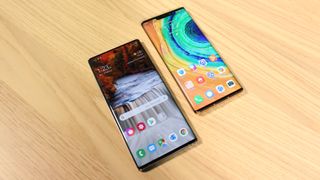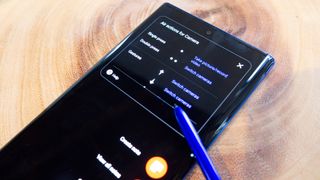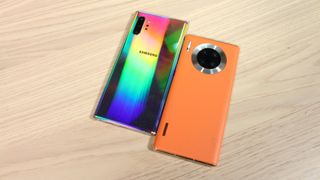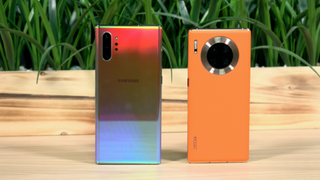Battle of the Phablets: Samsung Galaxy Note 10 Plus vs Huawei Mate 30 Pro
The top Android phones go head-on

If you're looking to purchase a high-end Android phone, the current choices are the Samsng Galaxy Note 10 Plus and the Huawei Mate 30 Pro. Each phone comes with it's set of advantages and drawbacks and we've compared the two to find out where each one excels.

Design and Display
Both the Huawei Mate 30 Pro and the Samsung Galaxy Note 10 Plus are large devices with big screens that need two hands to operate. The Note 10 Plus is larger when it comes to length and width and that is to accommodate the bigger screen which measures 6.8-inches compared to 6.53-inches on the Mate 30 Pro 5G.
If you’re looking for the larger screen, the Galaxy Note Plus wins but if you prefer a phone that is more manageable in your hands then we like the Mate 30 Pro more. It also has a more striking design with a waterfall screen and the optional vegan leather that look stunning in orange, especially with gold accents.
While both the phones sport an OLED display, Samsung has the lead which is no surprise as it is one of the largest manufacturers of display panels. The Note 10 Plus has a bigger and higher resolution screen with support for HDR10+ that give it an edge over the Mate 30 Pro.

Features and Performance
Under the hood the Samsung Galaxy Note10 Plus is powered by Exynos 9825 chipset while the Huawei Mate 30 Pro uses Huawei’s flagship the Kirin 990 chipset with integrated 5G- more on that in the next section. Huawei is using the latest 7nm+ technology which is newer and more efficient.
With RAM and storage, the Note 10 Plus comes with 12GB of RAM and 256GB of storage compared to 8GB of RAM and 256GB of storage on the Mate 30 Pro. Both phones use UFS 3.0 for storage.
Looking at the benchmarks, the Note 10 Plus scores 4532 and 10431 in single and multi-core scores under Geekbench whereas the Huawei Mate 30 Pro 5G scores 3851 and 12636 making is a bit slower in single core tasks but faster in multi-core tasks.
Get daily insight, inspiration and deals in your inbox
Get the hottest deals available in your inbox plus news, reviews, opinion, analysis and more from the TechRadar team.
While the phones are evenly matched for specs, Samsung does provide you the S-Pen with the Galaxy Note 10 for some added functionality.

Connectivity
Whereas both devices are similar in terms of design and features, the one area where Huawei pulls ahead is with connectivity which comes as no surprise as Huawei is one the pioneers of 5G technology.
Although the Galaxy Note 10 Plus comes with a 5G variant, it only supports the current NSA (Non-Standalon) 5G standard while the Mate 30 Pro 5G supports both SA (Standalone) and NSA (Non-Standalone) modes of 5G which means that your phone will support and enjoy higher speeds once network operators upgrade their infrastructure to true 5G instead of the current (NSA) hybrid LTE/5G architecture.
We’ve seen some network speed tests on Huawei Mate 30 Pro 5G which have reached speeds of 1,432 Mbps download- that's the fastest we’ve seen on any 5G device.

Camera
Huawei has built a solid reputation for being amongst the best in the industry when it comes to camera technology and with the Mate 30 Pro, Huawei pushes even further offering the industry’s first pair of 40MP cameras.
The primary 40MP camera on the Mate 30 Pro features the same RYYB sensor that we first saw on the Huawei P30 earlier this year that’s capable of taking stunning shots in daylight or lowlight. With the Mate 30 Pro, Huawei has focused on video and together with the 40MP Ultrawide lens, the 8MP telephoto that’s capable of 3X optical zoom and a 3D TOF sensor, you are awarded with the highest-spec camera in the phone industry.
On the Galaxy Note 10, Samsung hasn’t made much improvements compared to the S10 released earlier in the year. You get the same triple camera setup with 12MP sensor on the primary camera, 12MP of the telephoto with 12X zoom and 16MP on the ultrawide along with the TOF sensor.
The Galaxy Note 10 Plus is capable of taking some great shots but if you want better photos and videos, you’d be hard-pressed to find any phone that’s as versatile as the Mate 30 Pro.
Software
While Huawei pulls ahead with connectivity and camera, the one area where you will struggle with the Mate 30 Pro is with software due to the lack of Google Mobile services present on the phone. Huawei is building its own framework with Huawei Mobile services and getting more apps into its App Gallery every week. In fact, many of the popular apps used by users across the world are already preset on Huawei App Gallery and with the establishment of the Global Developer Service Alliance program, things will only get better.
Over time, this could pay off in a way that Apple currently enjoys with Huawei owning both the software and the hardware for a much more seamless and integrated solution. But for now, Google Play Store is the standard across all Android phones and the lack of that puts the Mate 30 Pro 5G at a disadvantage.
There are ways to add Google Mobile Services to the Mate 30 Pro but none of them are official methods that are guaranteed to continue working. Samsung, on the other hand, doesn’t have any political restriction placed on it and is thus allowed to bundle GMS and PlayStore on the Note 10 Plus which puts it at an advantage when it comes to apps.

Battery Life
Bigger devices mean bigger batteries and both the Huawei Mate 30 Pro and the Samsung Galaxy Note 10 Plus have very large capacity batteries that easily last a day and then some. In terms of capacity, the Note 10 Plus has a 4,300mAh battery while the Huawei Mate 30 Pro sports a 4,500mAh battery.
Both the phones support fast charging through USB Type-C and while both phones also support wireless charging, the Mate 30 Pro offers a faster 27W wireless charging compared to Samsung’s 15W wireless charging.
Price
Given the high-end design, features and performance, it should be clear that we are not looking at budget phones. Samsung does price the phone higher at AED 4,499 but the Huawei Mate 30 Pro 5G isn’t cheap at AED 3,899 either.
What you're getting out of the high-end specs, design and features of both phones, and considering the current market, the prices for these phones are justified.
Verdict
Both the Samsung Galaxy Note 10 5G and the Huawei Mate 30 Pro 5G are flagship products of each brand and will easily last you a few years. They excel at day-to-day use but do offer specific advantages- the Note 10 has a better screen and comes with the S-Pen.
There’s also the question on Google Apps and while we have no doubt that Huawei will continue to attract more add developers and grow its Mobile Services, Samsung does have the upper hand in software for the moment.
This could change in the future and if you are more interested on the hardware side than the software side, the Mate 30 Pro excels with a newer chipset, a better camera and a more future-proof 5G solution that will last you even when network operators switch to Standard Alone 5G infrastructure.

Abbas has been living and breathing tech before phones became smart or clouds started storing data. It all started when he got his very first computer- the Sinclair ZX Spectrum. From computers to mobile phones and watches, Abbas is always interested in tech that is smarter and smaller because he believes that tech shouldn’t be something that gets added to your life- it should be a part of your life.
Most Popular

